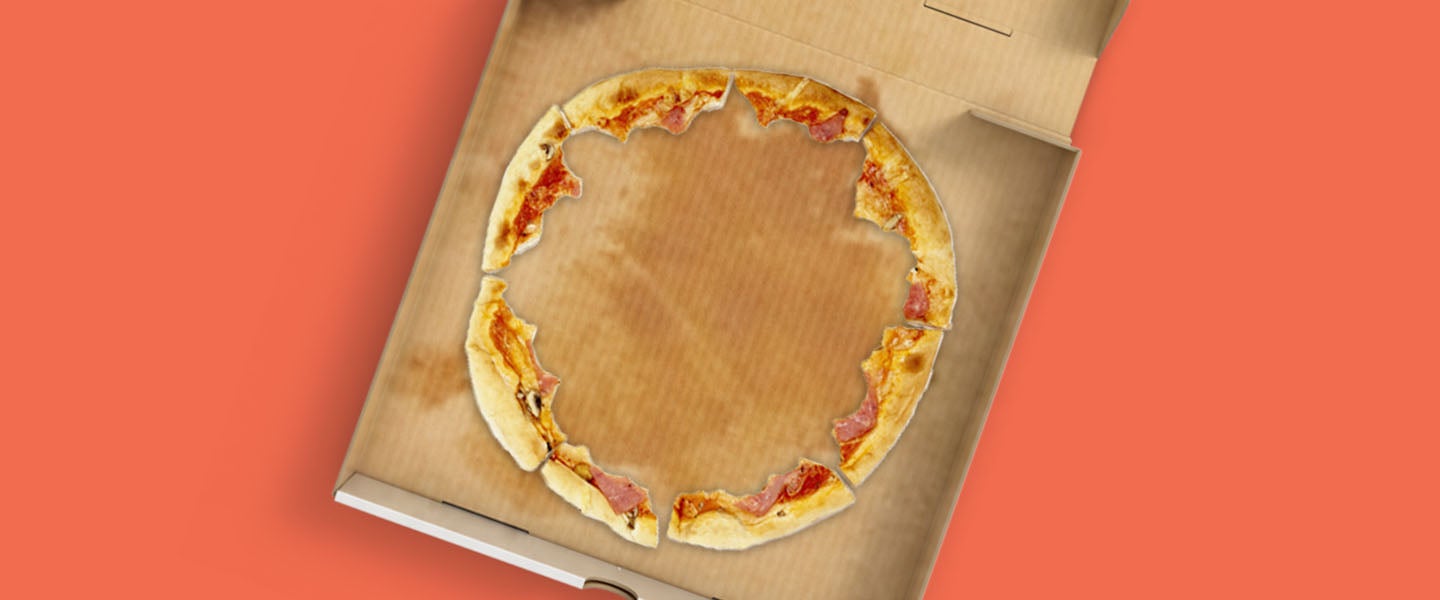We need not debate a couple of universal pizza truths: That pizza is both vital and inevitable, and that pizza is among the most nutritionally maligned foods on earth.
Understandably then, man has made valiant efforts to hack pizza, to whittle it down to some pizza-like formation that still resembles pizza without actually conferring pizza’s dark, gut-bomb-y downsides. You know, going meatless, cheeseless, sauceless and carb-less — taking out everything actually good and replacing it with a genuinely lesser substitute. No judgment, but that’s not for everyone. It’s essentially the Designer Impostors of perfume, promising me that Confess is as good as Calvin Klein’s Obsession. (If you like Pizza, you’ll love Saucy).
Surely there’s a better way. Take crusts. Pizza crusts, as essential as they may be to the pizza experience, are, in fact, optional. You can restrict your consumption to all the other pizza parts and still experience Total Pizza without ever biting into that hard, bone-dry, paltry excuse for a breadstick, and even technically reduce its nefarious powers. “I’d say that not eating the crust off pizza might save you about 50 to 75 calories per slice and perhaps 5 to 10 grams of carbohydrate,” explains Dana Hunnes, a clinical dietician at UCLA. “If you’re someone who can eat half a pizza in one sitting, that might mean saving yourself 200 to 300 calories and 20 to 40 grams of carbohydrate (depending on the size and thickness of the pizza).”
Some more pizza math:
- The average slice of cheese is around 250 calories (and around 400 for a heaping pile of meat atop that cheese, which, of course, is how God intended).
- The average person eats roughly three pieces per sitting.
- That’s between 750 to 1,200 calories before decrusting.
- After decrusting, however, it’s more like 600 to 900 calories.
Obviously, whether you leave those crusts to wither and die in the box is as much about crust philosophy and personal history as it is your health and physical fitness.
I, for one, don’t eat the crusts. Why? Maybe it’s the word “crust,” which instantly conjures bodily crust, eye crust, crust punk and the earth’s crust. Maybe it’s because I worked at Pizza Hut when they debuted the Stuffed Crust Pizza and became genuinely repulsed at laboring over those long cheese strings molded into dough.
Regardless, the crust doesn’t seem like real food to me. It’s food-like; it’s a reminder of food, or what the pizza would be if the pizza didn’t go right. It’s the pizza handle. It’s a pizza bone. It’s the edible rim of the plate the pizza sits on, and I don’t need a carb spoon to scoop up some ranch after eating all the good pizza parts already. It may as well be a disposable wrapper.
I understand this makes me a stupid baby.
I’m with Heather. Eat the crust, stupid baby. pic.twitter.com/5LfMThRu9R
— Richard Marx (@richardmarx) February 8, 2019
People who don't eat the pizza crust:
1. Why do you do that
2. Can I have it— Mara “Get Rid of the Nazis” Wilson (@MaraWilson) March 25, 2015
I also understand that people eat the crusts not only last, but sometimes first (nuts!), and also that rapper Jadakiss outdid all crust people everywhere when he one-upped us all and ordered an all-crust pizza from New York’s Cuts and Slices, upsetting many fans in the process.
Lastly, I understand that there are other ways to make your pizza healthier without having to pursue all the aforementioned meatless, cheeseless, sauceless and carb-less options (not to mention, crustlessness). Namely, Hunnes says, “Blotting off grease might save you about 45 calories per slice, perhaps slightly more.”
In other words, taking a napkin and patting down the pizza until it’s drenched and translucent with artery-clogging grease is more or less the same as not eating the crusts, and should be considered as an equally valid, official choice.
That said, Hunnes doesn’t share my bleak, no-pizza substitutes philosophy and claims there are versions of pizza that don’t fully compromise pizza and are technically better for you. “A better option would be to get significantly reduced amounts of cheese and thin-crust pizza with lots of veggies,” she explains. “That’s probably the best/healthiest way to get pizza without getting rid of all the ‘goodness.’”
She neglects to mention, though, that this is kind of a trick — i.e., because thin crust is so far from what most of us think of when we think of actual crust (basically, a big thick rind of hard bread), it’s more or less crustless already.
Therein lies the crux of the crust: To change pizza, you must define your pizza values and go from there. To love pizza is to embrace its flaws. Anything less than your perfect pizza, whatever that is, isn’t pizza. It’s Almost Pizza:
And that’s no world any of us can live in, no matter how you slice it.

